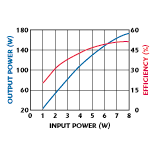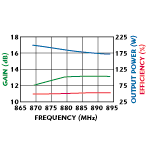A Tunable, Dielectric-loaded Waveguide Filter
K&L Microwave Inc.
Salisbury, MD
The personal communications service and cellular markets have placed high demands on filter manufacturers, including the need for low insertion loss with very high selectivity while maintaining 3 dB bandwidths of less than one percent. Fixed-frequency filters have been developed to achieve these features through various methods, including the use of dielectric resonators. Along with these requirements for increased filter performance, demands also exist for tunable filters, which are often used for testing communication systems and equipment. However, most standard tunable filters do not realize the unloaded Qs (Qu ) needed to achieve high performance levels. Previously, the most likely candidate for a high Qu tunable filter was the tunable air waveguide filter, which can achieve Qu s of 15,000 but has a distinct size disadvantage below approximately 6 GHz. The solution to this problem is a newly developed high performance tunable filter that utilizes dielectric-loaded waveguide.
Dielectric-loaded filters have been utilized for some time in fixed-frequency applications. Using the proven design criteria of these filters combined with new tunability techniques produces a tunable dielectric-loaded waveguide filter that features a significant size reduction compared to air waveguide types. The temperature-stable ceramic dielectric material used in the filter features high Qu s and reduces the cavity size while increasing waveguide filter performance.
Performance
The tunable dielectric-loaded waveguide filter, developed in four and five sections, has Qu values ranging from 15,000 to 28,000. These high Qu s allow filter designs to have narrow 3 dB bandwidths as low as 0.08 percent. Good selectivity is achieved by providing a 50 to 3 dB bandwidth shape factor of 4.3:1 for a four-section bandpass filter. This steep selectivity is achieved while maintaining an insertion loss of less than 3 dB and can be increased using a cross-coupling technique that tracks the tuned passband, providing shape factors of 2.7:1.
The cross-coupling technique places zeros on each side of the passband,  producing an elliptic response without increasing insertion loss. Figure 1 shows the performance of a 750 to 850 MHz, five-pole tunable filter tuned to an f0 of 800 MHz. The filter’s cross coupling provides a 50 to 3 dB shape factor of 2.3:1. The 3 dB bandwidth is 0.953 MHz with an insertion loss of 1.72 dB. A filter’s typical tuning range is approximately 18 percent of the desired low end center frequency f0 . For example, a filter with a low end f0 of 1700 MHz would have a high end of 1700 x 1.18 or 2000 MHz. Current designs offer tuning ranges from 600 to 2500 MHz.
producing an elliptic response without increasing insertion loss. Figure 1 shows the performance of a 750 to 850 MHz, five-pole tunable filter tuned to an f0 of 800 MHz. The filter’s cross coupling provides a 50 to 3 dB shape factor of 2.3:1. The 3 dB bandwidth is 0.953 MHz with an insertion loss of 1.72 dB. A filter’s typical tuning range is approximately 18 percent of the desired low end center frequency f0 . For example, a filter with a low end f0 of 1700 MHz would have a high end of 1700 x 1.18 or 2000 MHz. Current designs offer tuning ranges from 600 to 2500 MHz.
Operating in the familiar TE01 mode, the filter produces certain spurious responses. The solution to this problem is to utilize pole-placed lowpass filters to achieve –50 dB minimum rejection out to 6 GHz. The addition of the optional lowpass filter increases the insertion loss by approximately 1 dB. Currently, the filter is designed for low power and receive applications but also will be suitable for use in higher power situations in the near future.
Filter Configuration
The actual resonator tuning differs from conventional methods such as moving a metal disk above the ceramic resonator or moving a ceramic rod inside a ceramic ring. These methods either reduce the Qu drastically or produce a very short tuning range. In addition, these methods do not achieve the precision required for realizing sensitive narrowband filters. A new patent-pending method is used instead.
Figure 2 shows the filter’s basic construction. Two identical ceramic disks are located on top of each other in each cavity. One disk is fixed and the other is moved in proximity to the first. This method provides an extended tuning range and an almost constant Qu across that range.
located on top of each other in each cavity. One disk is fixed and the other is moved in proximity to the first. This method provides an extended tuning range and an almost constant Qu across that range.
With bandwidths less than one percent, the filter’s sensitivity is extraordinary. To overcome this sensitivity and compensate for imperfections in the ceramic disks, the resonators must be moved up and down without rotating. This task can be accomplished using a patent-pending drive assembly that converts the revolution of a stepper motor into a nonrotating linear motion, providing 0.00005" movement per motor step. Even with a drive assembly designed to allow a filter tuning accuracy of 50 kHz, the filter sections still may not be mechanically linked to achieve a tunable filter. To solve this problem, each filter section has its own dedicated stepper motor and drive assembly.
Without mechanically linking the sections, the stepper motors must be controlled individually, thereby moving each section to the appropriate position to achieve the desired filter response and center frequency. Because of inconsistencies between each filter section, the individual sections cannot be sent directly to their new filter positions. If they were, the filter would produce the appropriate response after achieving the desired f0 but the inconsistencies encountered during the transition may cause the filter to experience high SWR while tuning. This condition is not acceptable for most testing situations.
To solve this problem, a complex algorithm has been developed to drive the stepper motors from one commanded frequency to another while maintaining an operational filter response. The position of the moving ceramic disk is realized on power up using an optical index point. When the filter is commanded to a frequency, the algorithm uses preprogrammed data points to position the stepper motors and tune the filter. The time required for the filter to tune across a given band is less than 15 s. From the user’s perspective, the filter can be controlled using one of several digital interfaces, including binary-coded decimal, general-purpose interface bus (GPIB), RS-232, parallel and custom interfaces.
Conclusion
A filter has been developed that meets the specifications required for testing the latest communications system equipment. The tunable ceramic filter provides narrowband, low loss characteristics by utilizing newly developed mechanical techniques. Coupling these techniques with proven dielectric-loaded resonator technology produces a digitally controlled tunable filter that satisfies high performance demands with the integrity of long-proven designs.
K&L Microwave Inc.,
Salisbury, MD
(410) 749-2424.
